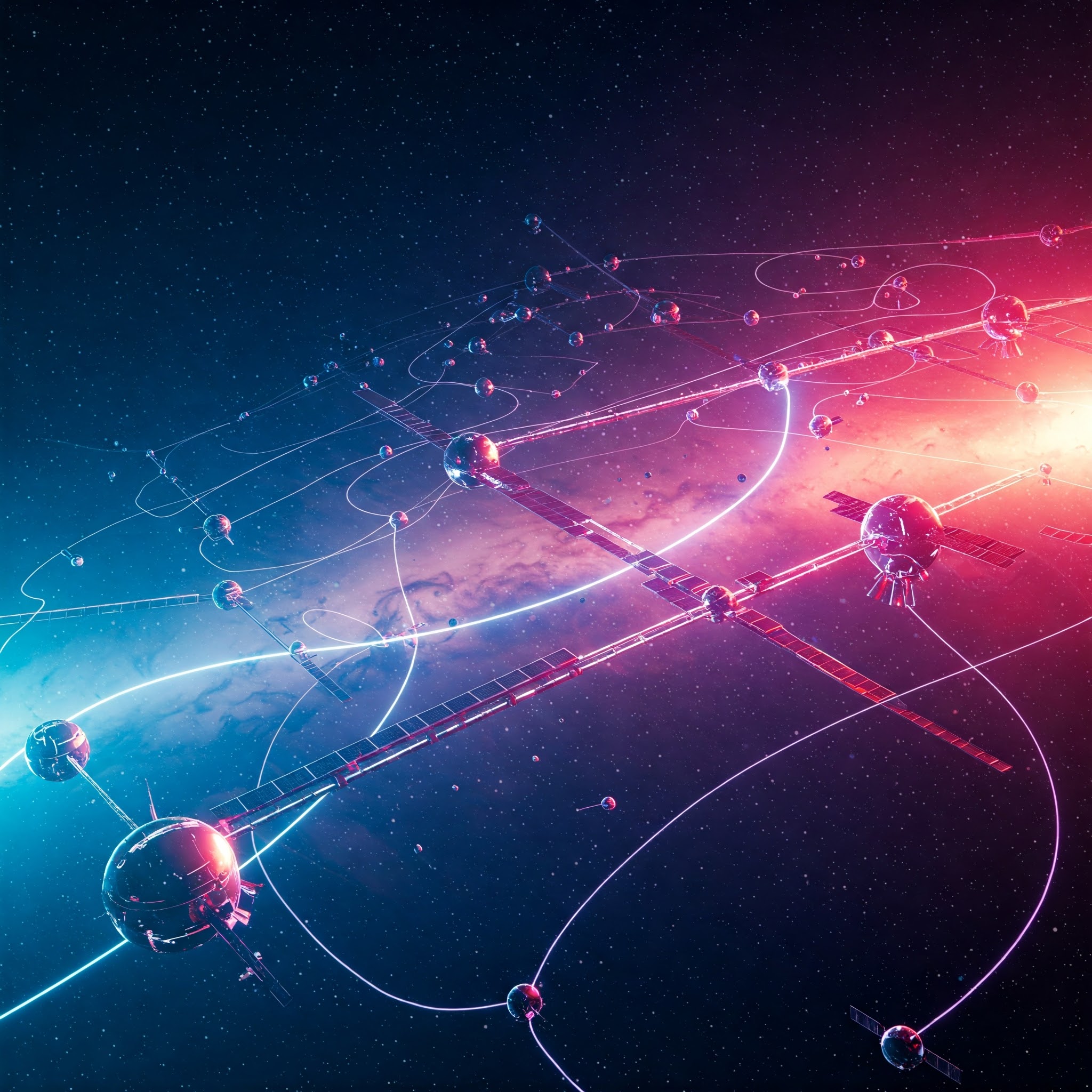Introduction
In the 21st century, the race to dominate outer space has entered a new phase—not through massive single satellites, but through the deployment of satellite mega-constellations. These vast networks of interconnected satellites orbiting the Earth are designed to provide global internet coverage, monitor environmental changes, support communication, and even enable space-based defense systems. As the number of satellites launched grows exponentially, satellite mega-constellations are redefining how humanity interacts with space.
This article explores what satellite mega-constellations are, their technological framework, benefits, concerns, and the global impact they will have on society, environment, and geopolitics.
What Are Satellite Mega-constellations?
A satellite mega-constellation is a network of hundreds or thousands of low Earth orbit (LEO) satellites that work in coordination to provide seamless, global coverage for various applications—primarily broadband internet and communications.
Unlike traditional satellite systems, which involve a few large satellites in geostationary orbit (GEO), mega-constellations operate in LEO, typically at altitudes between 300 km and 1,200 km. This proximity allows for:
- Lower latency
- Faster data transmission
- Higher bandwidth
- More flexible service
Key Players in Satellite Mega-constellations
Several private companies and national space agencies are actively developing or deploying satellite mega-constellations:
1. SpaceX – Starlink
- Aim: Global high-speed internet
- Number of satellites (as of 2025): Over 5,000 deployed; plans for 12,000+ in phase one, and up to 42,000 in total.
- Features: Phased array antennas, inter-satellite laser links
2. Amazon – Project Kuiper
- Goal: Deploy ~3,236 satellites
- Backed by Jeff Bezos
- Focus: Affordable internet access, especially in underserved areas
3. OneWeb
- UK-based company with backing from the British government and Bharti Enterprises
- Plans: Around 648 LEO satellites for broadband in remote regions
4. China – GuoWang Constellation
- State-backed initiative to deploy 13,000+ satellites
- Seen as a response to Western mega-constellations
5. Telesat Lightspeed (Canada)
- Offers broadband internet via LEO satellites to businesses and governments
Why LEO? Advantages Over GEO and MEO
| Parameter | LEO (Mega-constellations) | MEO | GEO (Traditional) |
|---|---|---|---|
| Altitude | 300–1,200 km | 2,000–35,000 km | ~35,786 km |
| Latency | ~20–50 ms | ~100 ms | ~600+ ms |
| Speed | Very high | Moderate | Slow |
| Coverage | Requires many satellites | Fewer needed | Wide, but fixed coverage |
| Launch Cost | Lower due to size/altitude | Higher | High |
Technology Behind Mega-constellations
1. Satellite Design
- Small satellites (<500 kg)
- Powered by solar panels
- Equipped with phased-array antennas for beam steering
- Include inter-satellite laser communication systems for data relay
2. Launch Mechanisms
- Reusable rockets (e.g., SpaceX’s Falcon 9)
- Mass deployment strategies (dozens launched at once)
- Upcoming vehicles like Starship to reduce cost per kg
3. Ground Infrastructure
- User terminals (small dish-like receivers)
- Gateway stations to link satellite data to the internet backbone
- Cloud infrastructure to manage satellite data
4. AI and Automation
- Used for satellite fleet management, collision avoidance, and frequency allocation
- Ground stations use AI to optimize routing and bandwidth allocation
Applications and Benefits
1. Global Internet Access
- Connects remote and underserved regions (e.g., mountains, deserts, oceanic zones)
- Supports rural education, e-health, and digital banking
- Crucial for developing countries with poor ground infrastructure
2. Disaster Response
- Provides real-time communication in disaster zones where ground infrastructure fails
- Helps in rescue operations, weather tracking, and rapid alerts
3. Military and Defense
- Real-time battlefield connectivity
- Surveillance and reconnaissance
- Secure and fast data communication
4. Economic Growth
- Empowers e-commerce, remote work, and digital learning
- Stimulates job creation in space tech, manufacturing, and AI sectors
Challenges and Concerns
Despite the benefits, satellite mega-constellations raise serious concerns:
1. Space Debris
- The increased number of satellites exponentially raises the risk of collisions
- Satellite failures or explosions contribute to orbital debris
- Kessler Syndrome: A cascade of collisions rendering LEO unusable
2. Light Pollution and Astronomy
- Satellite reflections interfere with ground-based astronomical observations
- Bright “satellite trails” contaminate data from telescopes
- Organizations like the International Astronomical Union (IAU) have raised red flags
3. Radio Frequency Interference
- Interference with Earth-based communication systems and scientific radio telescopes
4. Environmental Impact
- Rocket launches contribute to atmospheric pollution
- Satellite manufacturing and disposal raise sustainability issues
5. Regulatory and Geopolitical Tensions
- Lack of comprehensive international laws governing mega-constellations
- SpaceX’s dominance could lead to a digital monopoly
- Conflicts over orbital slots and radio frequencies
Regulatory Framework and Governance
1. National Regulations
- The U.S. FCC (Federal Communications Commission) licenses and regulates American satellite operators
- Countries like India and China have their own regulations through ISRO and CNSA
2. International Treaties
- Outer Space Treaty (1967): Prohibits sovereignty claims in space
- ITU (International Telecommunication Union): Allocates radio frequencies and orbital slots
3. Need for New Laws
- Current treaties don’t cover commercial mega-constellations
- There is a growing call for an International Space Traffic Management System
Environmental and Ethical Considerations
1. Sustainable Space Usage
- Active debris removal technologies are in development (e.g., ESA’s ClearSpace-1)
- De-orbiting mechanisms (drag sails, propulsion systems) being added to satellites
2. Equity and Access
- Internet access could be controlled by a few corporate entities
- Risk of “digital colonization” in the Global South
3. Ethical Surveillance
- LEO constellations may be used for real-time surveillance and data collection
- Raises privacy concerns if left unregulated
India’s Position in the Mega-constellation Race
India is emerging as both a beneficiary and a potential contributor to mega-constellations:
1. ISRO and IN-SPACe
- Developing indigenous satellite technology and regulatory framework for private space actors
- Exploring LEO satellite constellations for rural broadband
2. Bharti Group and OneWeb
- Bharti is a major investor in OneWeb, planning to provide services in India and South Asia
3. Private Sector
- Startups like Pixxel, Skyroot, and Agnikul are actively participating in small satellite and launch vehicle development
The Future of Satellite Mega-constellations
1. Integration with 5G and IoT
- LEO constellations will power backhaul for 5G towers in remote regions
- Enable real-time data exchange for millions of IoT devices
2. AI-Powered Space Internet
- Adaptive routing and network optimization
- Smart bandwidth allocation based on user demand
3. Lunar and Martian Constellations
- NASA and private players are exploring satellite networks for Moon and Mars colonization
4. Democratizing Space
- Reduced launch and manufacturing costs allow emerging nations and startups to enter the space race
Conclusion
Satellite mega-constellations symbolize a monumental shift in how we connect and communicate. By replacing limited, geostationary satellites with thousands of small, fast-moving satellites, these networks promise to bridge the global digital divide, offer resilient communications, and enable futuristic technologies like autonomous vehicles, smart agriculture, and global IoT.
However, the promise of this new era must be balanced with strong international regulations, ethical frameworks, and a commitment to sustainability. As more actors join the mega-constellation race, cooperation—not competition—will be key to ensuring a safe, inclusive, and prosperous space for all of humanity.




